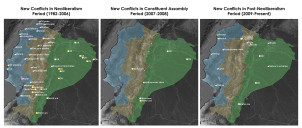
By Sara Latorre
These three maps on the geography and timeline of environmental injustices in Ecuador are part of my doctoral thesis (Latorre, 2013) and of an article to be published soon and co-authored with Katharine N. Farrell and Joan Martínez-Alier.
The aim of this article is to help advance in the understanding of the relationship between the commodification of nature, institutional change and patterns of conflict in Ecuador during the most recent phase of global capitalism. Ecuador is an interesting case of study as it is one of the few rich-resource periphery countries in the world that has moved, during this capitalist phase, from a neoliberal to a post-neoliberal policy regime. Generally speaking, scholars agree with the fact that Ecuador without abandoning the path of global integration as a supplier of primary commodities, has, since 2007, aimed to re-establish the role of the state in distributing wealth and to consolidate a national social contract through resource rents. Besides, it has been one of the major Latin American sites of important socio-environmental conflicts and social movements over extraction and exploitation of natural resources.
By analyzing 64 social conflicts during the period 1980-2013, we focus on the continuities and changes in the relationship between environmental dispossession and resistance in both Ecuadorian policy regimes.
We have relied on Harvey’s concept (2005) of “Accumulation by Dispossession” and also literature on political ecology to help structure our review of 64 concrete Ecuadorian conflicts cases. Furthermore, we have expanded Harvey’s understanding of the concept by considering the process of environmental cost shifting on the part of capitalist forms of production as another mechanism through which the dispossession is brought about. It is worth emphasizing that the study of a single country or region is not a disconnected object of study, on the contrary it represents a specific configuration of the ways in which the capitalist system is constituted and working.
Therefore, our inventory of Ecuadorian cases illustrate the ways in which global capitalism, through commodification, extraction and waste production, causes dispossession and resistance actions in Ecuador (but also in the Global South). In this sense, our inventory of Ecuadorian environmental conflicts, but also other inventory of conflicts already made, contributes to help advance the field of political ecology toward a kind of “statistical-based political ecology” with the aim to draw analytical generalizations on the relationship of environmental dispossession and resistance.
Finally, I would like to say that extended summaries of most cases will be soon available here in the European research project EJOLT.
Sara Latorre, PhD. Environmental Sciences and Technology
Institut de Ciència i Tecnologia Ambientals (ICTA).Universitat Autònoma de Barcelona


